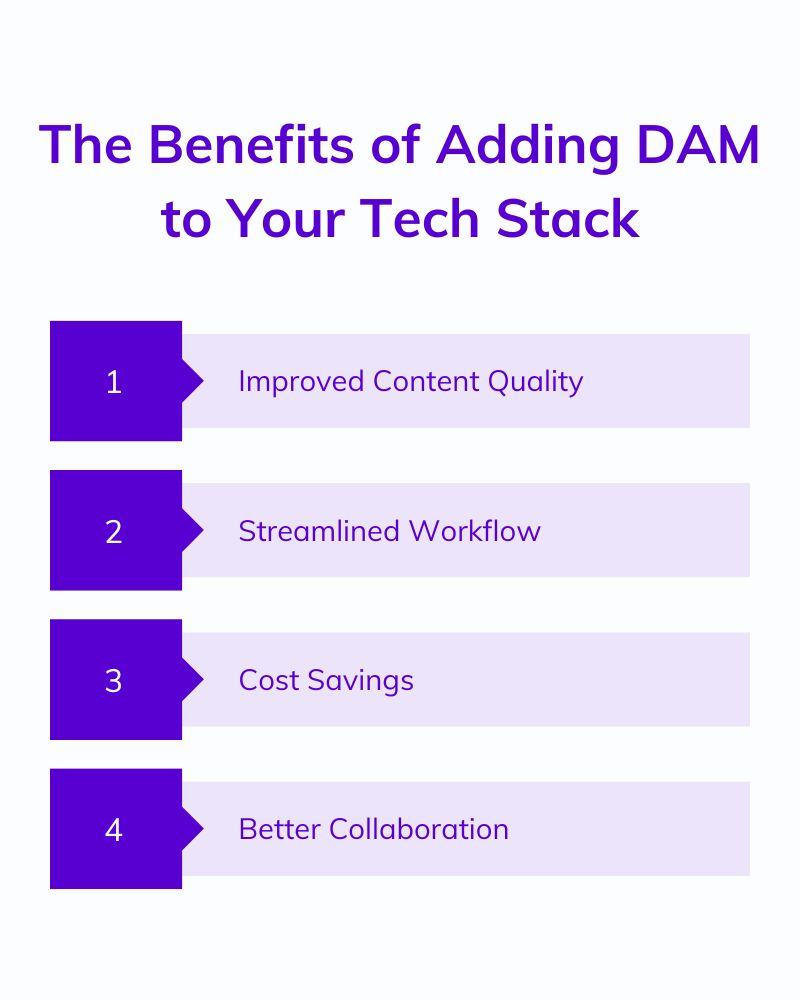Why integrate DAM into your Composable Tech Stack


In today's digital age, content is king. Whether it's photos, videos, or text, creating and distributing content is essential for businesses looking to connect with their target audience. However, managing a large volume of digital assets can be challenging, and this is where Digital Asset Management (DAM) comes in.
Integrating a DAM system into your tech stack can streamline your content management process, saving you time and money while improving overall content quality. This blog will explore why you should consider integrating DAM into your tech stack.
What is DAM?
DAM refers to organizing, storing, and distributing digital assets such as images, videos, and documents. DAM systems provide a centralized platform for managing digital assets, making finding, sharing, and using them more accessible. DAM platforms often include metadata management, version control, and access control, allowing you to control who has access to your assets and how they can be used.
While both DAM and Headless CMS systems deal with digital content, the main difference is that DAM systems are focused on managing digital assets, while Headless CMS platforms are designed to manage structured content and enable its delivery to multiple channels and devices. In some cases, a Headless CMS can also integrate with a DAM system to manage digital assets alongside structured content.
The Benefits of Adding DAM to Your Tech Stack

Improved Content Quality
One of the primary benefits of integrating DAM into your content platform/stack is that it can improve the quality of your content. With a DAM system, you can easily organize and store your assets to make them easier to find and use. This means that you'll spend less time searching for the right image or video and more time creating content that resonates with your audience. Additionally, DAM systems often include tools for metadata management, which can help you keep track of essential details about your assets, such as copyright information and usage rights. By ensuring that you have the right assets and that they're being used appropriately, you can improve the overall quality of your content.
Streamlined Workflow
Integrating DAM into your content platform/stack can also help streamline your workflow. With a centralized platform for managing your assets, you'll spend less time searching for the right files and more time creating content. Additionally, DAM systems often include features such as version control, which can help you keep track of changes to your assets over time. This can be particularly helpful when working on large projects involving multiple people or teams. Keeping everyone on the same page ensures that your content is consistent and meets your quality standards.
Cost Savings
Another benefit of integrating DAM into your content platform/stack is that it can save you money. Without a DAM system, you may spend money on duplicate assets or create new ones you already have. By centralizing your assets and making them easier to find, you can reduce the time and money you spend on asset creation. Additionally, DAM systems often include tools for usage rights management, which can help you avoid costly legal issues related to copyright infringement.
Better Collaboration
Finally, integrating DAM into your tech stack can improve team collaboration. With a centralized platform for managing your assets, you can ensure that everyone has access to the same files and works from the same asset version. This can be particularly helpful when working with remote teams or external partners. By providing a single source of truth for your assets, you can reduce the risk of miscommunication and ensure everyone is on the same page.
Agility's DAM Integrations: Bynder and Cloudinary
When it comes to integrating DAM into your tech stack, Agility offers seamless integrations with two popular DAM platforms: Bynder and Cloudinary.
Bynder is a cloud-based DAM platform that provides a centralized hub for managing all your digital assets. It offers robust features such as file management, digital rights management, and version control. By integrating Bynder with Agility, you can easily search and access your digital assets from within your CMS and quickly add them to your content. This saves time and reduces the risk of using outdated or incorrect assets.
Cloudinary is another cloud-based DAM platform that offers powerful digital asset management capabilities. With Cloudinary, you can upload, store, and manage all your digital assets in one place, with advanced features such as auto-tagging and image optimization. Integrating Cloudinary with Agility allows you to seamlessly access your digital assets and embed them into your content, providing a faster and more efficient content creation process.
Integrating Bynder or Cloudinary with Agility can also help you with branding consistency by allowing you to access and use approved assets, ensuring that all of your content is consistent and on-brand. Additionally, using a DAM system can help you stay compliant with copyright and usage rights by managing and tracking usage restrictions for each asset.
Conclusion
In today's digital age, creating and distributing content is essential for businesses looking to connect with their target audience. However, managing a large volume of digital assets can be challenging. Integrating a DAM system into your content platform/stack can streamline your content management process, saving you time and money while improving overall content quality.
Integrating DAM into your content platform/stack is a smart investment for any business looking to create and distribute high-quality content with benefits such as improved content quality, streamlined workflow, cost savings, and better collaboration.

About the Author
Harmonie is the Senior Marketing Manager at Agility CMS



